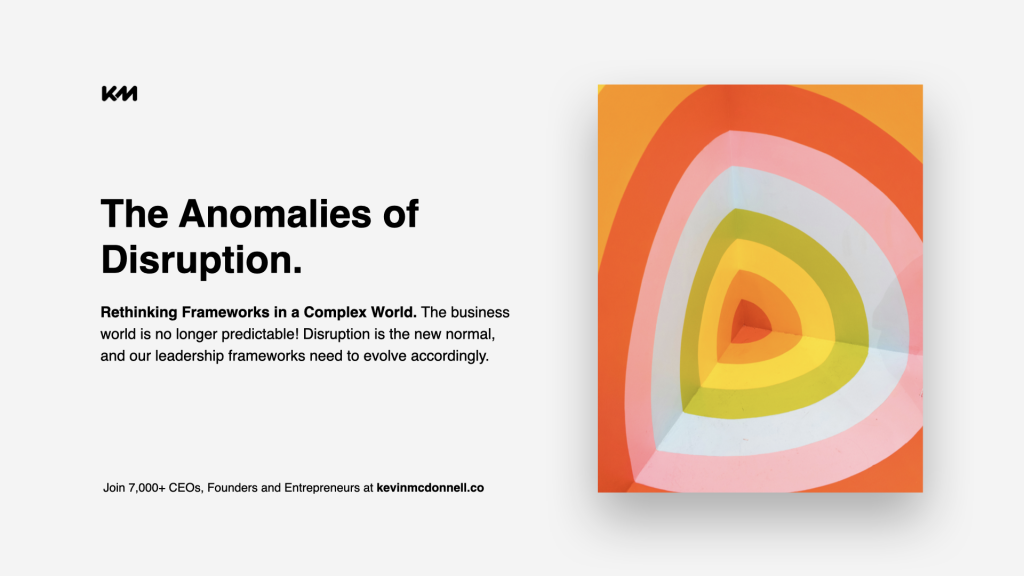The Anomalies of Disruption: Rethinking Frameworks in a Complex World

The business world thrives on frameworks. They provide structure, a common language, and a way to navigate the complexities of strategy, leadership, and decision-making. Yet, in an era of constant disruption, are these frameworks becoming crutches, hindering our ability to adapt and innovate?
I’ve spent years coaching and advising CEOs and leadership teams across industries. Frameworks are undeniably valuable tools. They can help us analyze situations, identify opportunities, and develop effective strategies. But what happens when the frameworks become outdated or fail to capture the nuances of an increasingly complex world?
Here’s the challenge: disruption is no longer a rare event. It’s the norm. New technologies, changing consumer behaviours, and unforeseen global events can rapidly reshape industries. Rigid adherence to traditional frameworks can leave leaders blindsided by these anomalies, hindering their ability to respond effectively.
Let’s consider an example. The classic SWOT analysis, a framework for evaluating Strengths, Weaknesses, Opportunities, and Threats, is a staple in strategic planning. But what if the very definition of a “strength” becomes obsolete overnight? Think of Blockbuster, once a dominant video rental chain whose brick-and-mortar model became a weakness when faced with the online streaming revolution.
The problem lies not with the frameworks themselves but in how we use them. We must move beyond a one-size-fits-all approach and embrace a more flexible, dynamic way of thinking. Here are some ways to do just that:
- Embrace the Anomaly: Don’t dismiss outliers or unexpected events as mere disruptions. Instead, view them as potential opportunities for innovation. Encourage your team to question assumptions and explore seemingly illogical possibilities.
- Focus on Agility, Not Just Alignment: Traditional frameworks often emphasize alignment around a single, pre-defined strategy. But in a rapidly changing environment, agility is paramount. Foster a culture of experimentation, rapid prototyping, and course correction based on real-time data and feedback.
- Build a Culture of Continuous Learning: Frameworks are snapshots of knowledge, not guarantees of future success. Invest in continuous learning within your organization. Encourage your team to stay abreast of emerging trends, new technologies, and competitor advancements.
So, what does this mean for the future of frameworks? We shouldn’t abandon them altogether. Instead, we need to develop a more nuanced relationship with these tools.
Here are some suggestions:
- Treat Frameworks as Inspiration, Not Prescription: Use frameworks as a starting point for discussion and exploration, not a definitive roadmap. Encourage healthy debate and challenge assumptions embedded within these structures.
- Develop Scenario Planning: Don’t limit yourself to a single “best case” scenario. Utilize frameworks to explore multiple future possibilities, including potential disruptions. This will help you develop contingency plans and cultivate a culture of preparedness.
- Embrace a “Minimum Viable Framework” Approach: Instead of spending months crafting a perfect, comprehensive plan, develop a “minimum viable framework” – a flexible, adaptable model that can be easily adjusted as new information emerges.
The goal is not to eliminate frameworks but to use them strategically. By fostering a culture of critical thinking, continuous learning, and adaptability, we can leverage the power of frameworks while remaining agile enough to navigate the anomalies of disruption.
The business world is no longer predictable! Disruption is the new normal, and our leadership frameworks need to evolve accordingly. By embracing the anomaly, prioritising agility, and adopting a more flexible approach to frameworks, we can empower our teams to thrive despite the unexpected.
